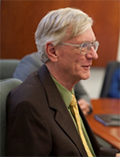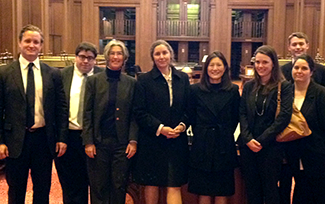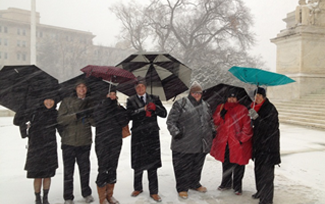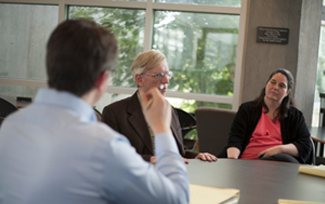Amicus Brief by UNM Law Team Plays Key Role in U.S. Supreme Court Decision
June 9, 2014
University of New Mexico School of Law Distinguished Professor Jim Ellis and a team of UNM Law faculty and students were instrumental in obtaining a recent Supreme Court ruling on how states can diagnose intellectual disability in capital cases. The friend-of-the-court brief received widespread attention from national as well as local news media.
The amicus brief Ellis and his UNM Law team filed in Hall v. Florida was to determine whether Florida's insistence on ignoring the scientifically-necessary standard error of measurement in IQ testing would allow people with an intellectual disability to be executed, contrary to the ban set out in Atkins v. Virginia, a case Ellis successfully argued in 2002.
 It was gratifying that the Court reaffirmed its commitment to protect individuals with intellectual disability from the death penalty," says Ellis (left). "All the hard work done by the members of our team helped the Court understand the technical issues involved, but also the reality of what this disability means in the lives of individuals like Mr. Hall."
It was gratifying that the Court reaffirmed its commitment to protect individuals with intellectual disability from the death penalty," says Ellis (left). "All the hard work done by the members of our team helped the Court understand the technical issues involved, but also the reality of what this disability means in the lives of individuals like Mr. Hall."
The amicus brief represents five professional and advocacy organizations in the fields of intellectual disability and disability rights. "Part of this case hinged on fairly esoteric information, such as details about correct scoring in psychological testing, which we explained in our brief," says Ann M. Delpha, a Staff Attorney, who coordinated the project. The brief outlines the definition of mental retardation, examines the role of IQ testing, clarifies the role of deficits in adaptive functioning, and examines the issue of "measurement of error" in determining a person's IQ.
Learning the advocacy process at the highest level

Part of the UNM Law team at the Supreme Court Building (l-r): Jason Kerkmans, Martin Juarez, Lynne Canning, Associate Dean for Clinical Affairs April Land, Professor Carol Suzuki, Kari Olson, Van Snow, and Staff Attorney Ann Delpha.
Once the petition was granted by the Court, Ellis had only about six weeks to recruit the team, conduct the research, and plan, organize, write and edit the brief. Delpha and Professors Steven Homer, April Land and Carol Suzuki helped Ellis draw up the brief and served as co-counsel with him in representing the disability organizations.
Delpha also coordinated the roles of students Lynne Canning, Emily Carey, Kylie Cook, Martin Juarez, Jason Kerkmans, Brian Moore, Kari Olson, Van Snow and Xochitl Liana Torres. The students helped with legal and psychological research, records review, and checking citations.
The students collaborated with faculty members at the law school, spending hours scrutinizing each word on the brief while juggling their courses and homework, through final exams, and during semester breaks, and then battled a blizzard in Washington D.C. to see the oral arguments in the Supreme Court.
It was the third time law student Martin Juarez worked on a brief for the Supreme Court with Ellis. "A death penalty case puts your life into perspective," says Juarez. "While you are working on those cases, you are constantly aware that, ultimately, someone will live or die. You carry that responsibility with you as you work on the brief."
 Jason Kerkmans (right) says the experience was an incomparable introduction to a legal career. "We learned every facet of constructing a brief– from the painstaking process of writing and editing a brief that will be scrutinized at the highest level, to conducting an oral argument, to managing a case with different amici. It's an invaluable experience and we'll be able to apply what we learned to any case or project."
Jason Kerkmans (right) says the experience was an incomparable introduction to a legal career. "We learned every facet of constructing a brief– from the painstaking process of writing and editing a brief that will be scrutinized at the highest level, to conducting an oral argument, to managing a case with different amici. It's an invaluable experience and we'll be able to apply what we learned to any case or project."
Kari Olson is interested in the field of intellectual disability and has taken as many classes as she could with Ellis. "Professor Ellis is legendary at the Law School," she says. "He is a national expert and one of the most highly qualified and respected professors in his field. All of us on the team feel it is a great honor to work with him on this brief."
"You don't have to attend Georgetown or Harvard to have the truly unique experience of working on a brief for the Supreme Court," says Olson. "You can get that experience right here at UNM."
 Van Snow (far left) took Advanced Constitutional Rights with Ellis and is very interested in the field. "In the classroom, Professor Ellis is knowledgeable about a whole range of issues," says Snow. "He is also incredibly nice and has a dry sense of humor. Those of us on the team got to see a whole other side of him as a zealous advocate: passionate and engaged in an issue that he feels very deeply about."
Van Snow (far left) took Advanced Constitutional Rights with Ellis and is very interested in the field. "In the classroom, Professor Ellis is knowledgeable about a whole range of issues," says Snow. "He is also incredibly nice and has a dry sense of humor. Those of us on the team got to see a whole other side of him as a zealous advocate: passionate and engaged in an issue that he feels very deeply about."
Lynne Canning says that Ellis's understanding of the nuances of intellectual disability law is a "revelation" and adds, "I really appreciated how we, as students, were able to participate collaboratively in every step of the process, from researching state legislation, to reviewing the brief, line by line, word by word, to meticulously checking citations. And sitting around the table working collaboratively with professors and other students to make the brief as ‘perfect' as it could be was the most fun I've had in law school!"
Making it to Justice Ginsberg's "Read" pile
"Professor Ellis says Justice Ginsberg has three piles for briefs – read, skip, or skim. He wants to make absolutely certain that his briefs are in the ‘read' pile," recounts Olson. "So he strives for perfection. He drives home the importance of each step in the process – crafting the argument and scrutinizing the placement of each word and each type of punctuation."
The attention to detail and hours spent examining each word and each period paid off. "It's painstaking, detailed work, but the resulting brief submitted by Professor Ellis and the team was described by an experienced Supreme Court practitioner as a ‘work of art,' demonstrating for students how the attention results in an exquisite brief," says Land.
Seeing the Supreme Court in action

Battling the blizzard are: (l-r) Professor Carol Suzuki; students Van Snow, Kari Olson, Jason Kerkmans, and Martin Juarez; Staff Attorney Ann Delpha; and student Lynne Canning.
The day the case was heard, a blizzard struck Washington, D.C., rendering the city almost immobile. Busses weren't running; most of the business and government world had come to a halt. While the Supreme Courtroom holds about 400 people, it may only have space for about 50 public observers, depending on reserved seating, so the team battled the blizzard to be in line at 4:30 a.m. to ensure they could get a seat.
At 7:15, the court's main doors opened, and after everyone cleared security, arguments were made by Seth P. Waxman, Washington, D. C. for the petitioner and Allen Winsor, Solicitor General, Tallahassee, Fla., for the respondent. "The intimacy of the courtroom surprised me," says Snow. "We were so close to the Justices and to the arguing attorneys that we could read their body language and see their facial expressions."
"The weight of the issue permeated the atmosphere," adds Kerkmans. "Everyone in that courtroom was aware of the consequences, creating a noticeable density in the air."
Reflecting on the overall experience for the students, Land says, "The students had the privilege of seeing a high-level team in action. They learned about the importance of paying exacting attention to detail to wording that would be scrutinized by the highly sophisticated Supreme Court analysis. And they had the opportunity to see how arguments are made at the highest level."
 Delpha (right) and one of the other faculty members on the UNM team had never been to the Supreme Court before. "Watching arguments in a case I helped brief was a once in a lifetime opportunity for me," she comments. "I hope to see at least one of our students at the Supreme Court's podium arguing a case one day. Any and all of them will know how to build the skills to do it after this experience."
Delpha (right) and one of the other faculty members on the UNM team had never been to the Supreme Court before. "Watching arguments in a case I helped brief was a once in a lifetime opportunity for me," she comments. "I hope to see at least one of our students at the Supreme Court's podium arguing a case one day. Any and all of them will know how to build the skills to do it after this experience."
